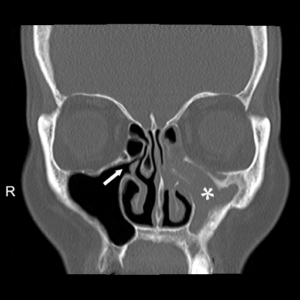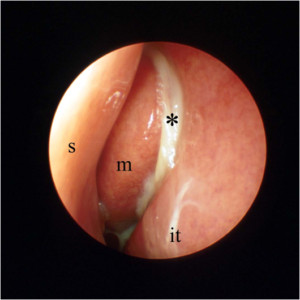Home / Nose Sinuses / Sinusitis
Sinusitis
Call +65 8125 3580
for 24 by 7 appointment
What is sinusitis?
What is sinusitis? “I have sinus” is a common complaint which patients present to the doctor. Patients often use the term ‘sinus’ to refer to a variety of nasal conditions, ranging from simple allergies of the nose to true sinus infections and major ailments affecting the nose and sinuses. Strictly speaking the term “sinus” means an air cavity. There are several air cavities around the nose that open into the nasal cavity through very narrow channels. These air cavities are located in the forehead bone and are called the frontal sinuses, in the cheek bone and are known as the maxillary sinuses, between the eyes and are called the ethmoid sinuses and lastly at the back of the nose almost in the center of the head and are called the sphenoid sinus. Thus, there are four pairs of sinuses.
Like any other part of the body, these sinuses are predisposed to infection, polyp formation, benign growths and tumors. In a healthy state the sinuses are sterile. They may however get infected by extension of the infection from the nose. The term “sinusitis” is used when the mucosal lining of the sinuses get inflamed. The inflammation may be due to a variety of causes including, viral infection, bacterial infection, fungal infection, smoking, allergies etc. Infections affecting the sinuses may be acute or chronic.If the infection lasts for less than 4 weeks it is defined as an acute infection and when it persists more than 12 weeks it is termed a chronic infection. Between the period of 4 weeks and 12 weeks the infection may be termed as sub-acute. Whereas an acute infection is often bacterial, a chronic infection may be due to several attributing factors that may involve allergies, structural problems with in the nose, immunological issues, smoking, etc. Acute sinusitis typically follows a viral upper respiratory tract infection. Pain, purulent nasal discharge and sometimes fever are the classical presenting symptoms. Chronic sinusitis (CS) is often more difficult to diagnose. The symptoms of CS are varied, and may include the following facial pressure, pain, congestion and/or fullness, nasal obstruction, nasal discharge or postnasal drip, fatigue, dental pain, cough and ear pressure.
 CT scan : Note the maxillary sinus on the right side is healthy and appears black on the CT scan. This is because the sinus in a healthy state contains air and will appear black on the CT scan. The arrow points to the opening of the right maxillary sinus into the nasal cavity. In contrast, the left maxillary sinus (asterisk) is completely grey as all the air in this sinus has been replaced with pus
CT scan : Note the maxillary sinus on the right side is healthy and appears black on the CT scan. This is because the sinus in a healthy state contains air and will appear black on the CT scan. The arrow points to the opening of the right maxillary sinus into the nasal cavity. In contrast, the left maxillary sinus (asterisk) is completely grey as all the air in this sinus has been replaced with pus
 Image showing nasal endoscopic examination of a patient with sinusitis. Note the pus in the nasal cavity (black asterisk*). Other nasal structures in the above image are the nasal septum “s”, the middle turbinate “m” and the inferior turbinate “it”.
Image showing nasal endoscopic examination of a patient with sinusitis. Note the pus in the nasal cavity (black asterisk*). Other nasal structures in the above image are the nasal septum “s”, the middle turbinate “m” and the inferior turbinate “it”.
A careful history and meticulous examination, including nasal endoscopy and Imaging studies such as CT scan are necessary to make the diagnosis of sinusitis.
Are you experiencing symptoms of sinusitis? Speak to A/Prof Sethi to find out if this is the medical condition you have at +65 8125 3580. Or book an appointment with A/Prof Sethi for a consultation on your symptoms and treatment options.
